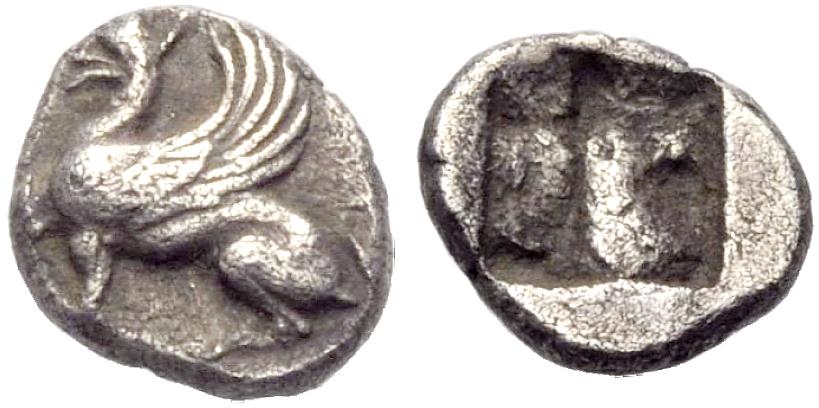Abdera, silver, obols (540-492 BCE): Difference between revisions
From SILVER
No edit summary |
m (Callatay moved page AC 102c - Abdera, silver, obols (540-492 BCE) to Abdera, silver, obols (540-492 BCE)) |
||
| (4 intermediate revisions by the same user not shown) | |||
| Line 1: | Line 1: | ||
{{Die Study | {{Die Study | ||
|Image=AC102c Abdera obol.jpg | |||
|Image reference=https://pro.coinarchives.com/a/lotviewer.php?LotID=634135&AucID=1161&Lot=29 | |||
|Obverse description=Griffin seated left, raising forepaw | |||
|Reverse description=Quadripartite incuse square | |||
|Mint=Abdera | |Mint=Abdera | ||
|Ancient region=Thrace | |||
|Date from=540 BCE | |Date from=540 BCE | ||
|Date to=492 BCE | |Date to=492 BCE | ||
| Line 9: | Line 14: | ||
|RQEM reference=RQMAC | |RQEM reference=RQMAC | ||
|RQEM reference number=102c | |RQEM reference number=102c | ||
|Die study reference= | |Die study reference=May 1966, p. 65-66. | ||
|Number of obverse dies= | |Coin series reference=Sear I, n° 1338; RQEMAC, n° 102c ; HGC 3.2, n° 1152 | ||
|Number of reverse dies= | |Number of obverse dies=3 | ||
|Number of coins= | |Number of singletons=3 | ||
|Number of reverse dies=3 | |||
|Number of coins=3 | |||
|Workstation=Most likely one single workstation | |||
}} | |||
{{Distribution Item | |||
|Frequency=1 | |||
|Number of dies=3 | |||
|Die name=22, 23, 24 | |||
}} | }} | ||
Latest revision as of 17:43, 11 May 2023
540 BCE - 492 BCE Silver 2,294 kg
Description
| ObverseInscription or printing placed on the obverse.: | Griffin seated left, raising forepaw |
| ReverseInscription or printing placed on the reverse.: | Quadripartite incuse square |
Mint and issuing power
| MintIdentifies the place of manufacture or issue of a numismatic object.: | Abdera | Ancient regionAncient region.: | Thrace | Modern countryModern country: Greece | AuthorityIdentifies the issuing power. The authority can be "pretended" when the name or the portrait of X is on the coin but he/she was not the issuing power. It can also be "uncertain" when there is no mention of X on the coin but he/she was the issuing power according to the historical sources: |
Chronology
| FromIdentifies the initial date in a range assigned in a numismatic context. | 540 BCE | toIdentifies the final date in a range assigned in a numismatic context.. | 492 BCE | PeriodTime period of the numismatic object.: Archaic until 480 BC |
Physical description
| MetalThe physical material (usually metal) from which an object is made.: | Silver |
Median weightMedian of the weights of numismatic objects (in grams). in grams | 0.65 | DenominationTerm indicating the value of a numismatic object. Examples: tetradrachm, chalkous, denarius.: | obol |
StandardStandard.: |
Obverse dies distribution
| FrequencyFrequency of specimen in distribution. ᵖ | Number of obversesNumber of obverse dies. ᵖ (o) | % (o) | Number of coinsNumber of coins. (n) | % (n) | Die nameName(s) of the die(s). |
| 1 | 3 | 100 | 3 | 100 | 22, 23, 24 |
| Total | 3 of 3 | 100 | 3 of 3 | 100 |
Reverse dies distribution
no distribution is available
Quantification
| Number of obversesNumber of obverse dies. ᵖ (o) | 3 | Number of singletons (o1)The number of singleton coins. ᵖ | 3 |
| Number of reverse diesNumber of reverse dies. (r) | 3 | Number of coinsNumber of coins. (n) | 3 |
| Coins per obverse dieNumber of coins per obverse die. (n/o) | 1 | Coins per reverse dieNumber of coins per reverse die. (n/r) | 1 |
| Reverse per obverse ratioRatio of obverse dies divided by reverse dies. (r/o) | 1 | Percentage of singletons (o1)number of coins (n) divided by the number of singletons (o1) ᵖ | 100 % |
| Original number of dies (O) (Carter 1983 formula)The estimation of the number of coins according to Carter 1983 ᵖ | 176.47 | Coins struck if 20,000 as average productivity per dieCoins made if the average productivity for obverses (according to Carter) is 20,000. ᵖ | 3,529,400 |
| Original number of dies (O) (Esty 2011 formula)The estimation of the number of coins according to the singleton formula in Esty 2011 ᵖ (O) | Survival rate if 20,000 as average productivity per dieSurvival rate if average productivity is 20,000. ᵖ | 0.00000 | |
| Coverage (o = % of O) (Esty 1984 formula)Esty 1984 - coverage (% of O) ᵖ (o = % of O) | 0% | Die productivity if survival rate 1/2,000Average productivity if survival rate is 1/2,000. ᵖ | 34 |
| Weight of silver (in kg) if 20,000 coins per die (O = Carter formula)Carter 1983 * Median weight * 20000 (*10 if gold or electrum) ᵖ | 2,294 kg <br /> 2,294 kg | Die productivity if survival rate 1/5,000Average productivity if survival rate is 1/5,000. ᵖ | 85 |
Remarks
Most likely one single workstation
